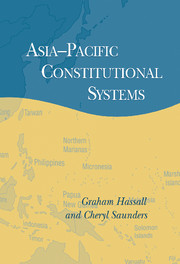Book contents
- Frontmatter
- Contents
- Acknowledgements
- Map: The Asia-Pacific Region
- Introduction
- Part I Modernity and Nation-States at the Dawn of the Global Era
- Part II The Constitution of Modernity
- Part III Democracy and the Rule of Law
- Conclusion: Postmodernity and constitutionalism
- Appendix: Chronology of constitutional events in the Asia Pacific
- Bibliography
- Index
Appendix: Chronology of constitutional events in the Asia Pacific
Published online by Cambridge University Press: 09 October 2009
- Frontmatter
- Contents
- Acknowledgements
- Map: The Asia-Pacific Region
- Introduction
- Part I Modernity and Nation-States at the Dawn of the Global Era
- Part II The Constitution of Modernity
- Part III Democracy and the Rule of Law
- Conclusion: Postmodernity and constitutionalism
- Appendix: Chronology of constitutional events in the Asia Pacific
- Bibliography
- Index
Summary
Bangladesh1953 Constituent assembly dissolved. Elected prime minister dismissed by governor-general.
1956 Constituent convention adopts constitution with parliamentary form of government, president as head of state, and prime minister as head of government.
1958 1956 Constitution abrogated and martial law proclaimed.
1962 Constitution promulgated. Presidential form of government introduced.
1969 Constitution abrogated by military intervention.
1970 Election held for constituent assembly. 3 March: constituent assembly halted by military head of state. 16 December: Pakistani military forces defeated.
1971 Independence gained following civil war with West Pakistan. 10 April: first meeting of Constituent Assembly of Bangladesh.
1972 4 November: constitution adopted. Parliamentary system introduced.
1975 24 January: presidential system introduced. 15 August: president assassinated. Constitution suspended, and a former minister assumes office of president until removed by military intervention.
1978 April: presidential election. Opposition parties seek reversion to parliamentary form of government.
1981 29 May: president assassinated. October: incumbent vice-president elected president.
1982 24 March: president removed by military coup.
1986 'Election' to office of president widely considered rigged.
1991 Twelfth Amendment restores parliamentary form of government.
1994 March: three main opposition parties boycott parliament and eventually resign en masse in bid to have general elections held under neutral caretaker government.
1995 25 November: prime minister asks president to dissolve parliament.
- Type
- Chapter
- Information
- Asia-Pacific Constitutional Systems , pp. 250 - 279Publisher: Cambridge University PressPrint publication year: 2002



